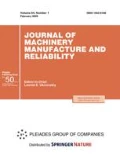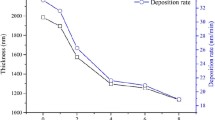Abstract
The effect of the main thermal sputtering parameters on the cohesive strength of the coating with respect to the substrate surface is considered. At the stages of particle heating, acceleration, transfer, and contact, the relationships between the parameters of the sputtering process and the factors that determine the cohesive strength between the sputtered material and the substrate surface have been revealed. The relationships between the cohesive strength and the technological parameters and sputtering modes in the operations of applying and machining of functional resistant coatings are formalized.



Similar content being viewed by others
REFERENCES
Korobov, Yu.S., International Conference and Exhibition on Thermal Spraying ITSC 2010: Review and Analysis, Materialy Mezhdunarodnogo nauchno-prakticheskogo seminara (28–29 oktyabrya 2010 g.). Termicheskoe napylenie. Sovremennoe sostoyanie (Proc. Int. Scientific and Practical Seminar (October 28–29, 2010). Thermal Spraying. State of the Art), 2010, p. 4.
Albagachiev, A.Yu., Stavrovskii, M.E., and Sidorov, M.I., Tribological wear-preventive coatings, J. Mach. Manuf. Reliab., 2020, vol. 49, pp. 57–63.
Vasil’ev, A.S. et al., in Napravlennoe formirovanie svoistv izdelii mashinostroeniya (Directed Formation of Properties of Mechanical Engineering Products), Kondakov, A.I., Ed., Moscow: Mashinostroenie, 2005.
Dal’skii, A.M., Bazrov, B.M., Vasil’ev, A.S., et al., in Tekhnologicheskaya nasledstvennost’ v mashinostroitel’nom proizvodstve (Technological Heredity in Mechanical Engineering), Dal’skii, A.M., Ed., Moscow: MAI, 2000.
Yashcheritsyn, P.I., Ryzhov, E.V., and Averchenkov, V.I., Tekhnologicheskaya nasledstvennost’ v mashinostroenii (Technological Heredity in Mechanical Engineering), Minsk: Nauka i Tekhnika, 1977.
Voronin, N.A., The effective and true adhesive strength of thin protective coatings, J. Mach. Manuf. Reliab., 2019, vol. 48, pp. 320–327.
Kalita, V.I. and Komlev, D.I., Plazmennye pokrytiya s nanokristallicheskoi i amorfnoi strukturoi (Plasma Coatings with Nanocrystalline and Amorphous Structure), Moscow: Lider M, 2008.
Kudinov, V.V. and Bobrov, G.V., Nanesenie pokrytii napyleniem. Teoriya, tekhnologiya i oborudovanie. Uchebnik dlya vuzov (Spray Coating. Theory, Technology, and Equipment. Training Manual for Universities), Moscow: Metallurgiya, 1992.
Khasui, A. and Morigaki, O., Naplavka i napylenie (Surfacing and Spraying), Moscow: Mashinostroenie, 1985.
Puzryakov, A.F., Teoreticheskie osnovy tekhnologii plazmennogo napyleniya: Ucheb. posobie po kursu “Tekhnologiya konstruktsionnykh materialov” (Theoretical Foundations of Plasma Spraying Technology: Training Manual for the Course “Technology of Structural Materials”), Moscow: Mosk. Gos. Tekh. Univ. im. N.E. Baumana, 2008, 2nd ed.
Baldaev, L.Kh., Borisov, V.N., Vakhalin, V.A., et al., Gazotermicheskoe napylenie. Ucheb. posobie (Gas Thermal Spraying: Handbook), Baldaev, L.Kh., Ed., Moscow: Market DS, 2007.
Il’yushenko, A.F., Shevtsov, A.I., Okovityi, V.A., et al., Protsessy formirovaniya gazotermicheskikh pokrytii i ikh modelirovanie (Processes of Formation of Thermal Coatings and Their Modeling), Minsk: Belarus. Navuka, 2011.
Yaroslavtsev, V.M., Obrabotka gazotermicheskikh pokrytii rezaniem. Ucheb. posobie (Processing of Gas-Thermal Coatings by Cutting: Handbook), Moscow: Mosk. Gos. Tekh. Univ. im. N.E. Baumana, 2013.
Kuz’min, V.I., Golubev, M.P., Tyryshkin, P.A., and Dolmatov, A.V., Visualization of the gas-dynamic structure of plasma flows of the “PNK-50” spray plasmatron by the shadow method, Vestn. Yugorsk. Gos. Univ., 2018, no. 4, p. 61.
Tillmann, W., Hagen, L., Schaak, C., Liß, J., Schaper, M., Hoyer, K.-P., Aydinöz, M.E., and Garthe, K.-U., Adhesion of HVOF-sprayed WC-Co coatings on 316L substrates processed by SLM, J. Thermal Spray Technol., 2020, no. 29, p. 1396.
Ashok Meghwal, Ameey Anupam, Murty, B.S., Berndt, C.C., Ravi Sankar Kottada, and Andrew Siao Ming Ang, Thermal spray high-entropy alloy coatings: A review, J. Thermal Spray Technol., 2020, no. 29, p. 857.
Mauer, G., Vaßen R., and Stöver, D., Plasma and particle temperature measurements in thermal spray: Approaches and applications, J. Thermal Spray Technol., 2011, vol. 20, pp. 391–406.
Jing Xue and Min Huang, Optimization of plasma spray process via orthogonal test design method, SVM, and improved PSO, Int. J. Mater. Mech. Manuf., 2017, vol. 3, no. 5, p. 153.
Lyphout, C., Nylen, P., and Östergren, L.G., Adhesion strength of HVOF sprayed IN718 coatings, J. Thermal Spray Technol., 2012, no. 21, p. 86.
Yongjing Cui, Mengqiu Guo, Changliang Wang, and Zhihui Tang, Adhesion enhancement of a metallic Al coating fabricated by detonation gun spray on a modified polymer matrix composite, J. Thermal Spray Technol., 2019, vol. 28, p. 1730.
Vignesh, S., Shanmugam, K., Balasubramanian, V., and Sridhar, K., Identifying the optimal HVOF spray parameters to attain minimum porosity and maximum hardness in iron based amorphous metallic coatings, Def. Technol., 2017, no. 13, p. 101.
Pulido-Gonzalez, N., Garcia-Rodriguez, S., Campo, M., Rams, J., and Torres, B., Application of DOE and ANOVA in optimization of HVOF spraying parameters in the development of new Ti coatings, J. Thermal Spray Technol., 2020, vol. 29, p. 384.
Klimenko, G.K. and Lyapin, A.A., Generatory plazmy: Metod. ukazaniya k vypolneniyu kursovogo proekta (Plasma Generators: Methodical Instructions for the Course Project), Moscow: Mosk. Gos. Tekh. Univ. im. N.E. Baumana, 2010.
Ramachandran, C.S., Balasubramanian, V., and Ananthapadmanabhan, P.V., Multiobjective optimization of atmospheric plasma spray process parameters to deposit yttria-stabilized zirconia coatings using response surface methodology, J. Thermal Spray Technol., 2011, vol. 20, p. 590.
Nylé, P., Hansbo, A., Friis, M., and Pejryd, L., Investigation of particle in-flight characteristics during atmospheric plasma spraying of yttria stabilized ZrO2: Part 2. Modeling, J. Thermal Spray Technol., 2001, no. 10, p. 359.
Okovityi, V.A., Panteleenko, F.I., Okovityi, V.V., and Astashinskii, V.M., Plasmatron for coating, Nauka Tekh., 2019, no. 18, p. 5.
Kravchenko, I.N., Karelina, M.Yu., Zubrilina, E.M., and Kolomeichenko, A.A., Resource-saving technologies for obtaining functional nanostructured coatings by high-speed deposition methods, Vestn. Donsk. Gos. Tekh. Univ., 2015, no. 3, p. 19.
Author information
Authors and Affiliations
Corresponding authors
Ethics declarations
The authors declare that they have no conflict of interest.
Additional information
Translated by O. Polyakov
About this article
Cite this article
Kovalev, A.A., Krasko, A.S. Effect of the Thermal Sputtering Parameters on the Cohesive Strength of Functional Resistant Coatings. J. Mach. Manuf. Reliab. 50, 208–215 (2021). https://doi.org/10.3103/S1052618821030080
Received:
Accepted:
Published:
Issue Date:
DOI: https://doi.org/10.3103/S1052618821030080




